Florida Trees and Shrubs
Page 2 of 11
On this page - Mahogany, Gallberry, American Sycamore, Bald Cypress, Red Maple, Silver Maple, Water Hickory, Pond Apple, Florida Fiddlewood, Swamp Cyrilla, Carolina Ash, Melaleuca, Earleaf Acacia
Mahogany - Swietenia mahagoni
Family - Meliaceae
Native
_small.jpg)

_small.jpg)
Habitat -Hammocks of extreme southern Florida and the Keys
Florida tree capable of reaching 75 to 80 feet in height, more common at 35 - 40 feet. Bark on older trees is dark brown and deeply fissured. Dark green leaves are alternate, pinnately compound - leaflets are ovate to lanceolate with entire margins.
Native Mahogany trees were heavily logged in the past for the strong, attractive wood and it is now a threatened species with-in the state, occurring naturally only in extreme southern Florida. The large (up to 6 inches) hard seed pods will split open while still on the tree releasing hundreds of winged seeds. The seed pods are also heavy enough to cause damage to a vehicle parked below if blown down by a storm or other strong wind. Mahogany is widely used in South Florida as a landscape tree and the seeds will readily sprout and are fast growing when young.
American Sycamore - Platanus occidentalis
Family - Platanaceae
Native
_small.jpg)
%20leaf_small.jpg)
%20leaf%20bot_small.jpg)

Habitat - River floodplains, Bottom land forests
Usually thought of as a northern tree, Sycamore is also a Florida native tree and has been documented in the wild as far south as the southern end of Lake Okeechobee and is used as a landscape tree as far south as Martin county.
Long lived and fast growing to a height of 170 feet with massive, sometimes hollow trunks, the Sycamore tree prefers moist to wet soils. Leaves are large alternate, simple, ovate with 3-5 lobes and coarsely toothed margins. Bark is reddish brown and scaly, broken up in to irregular plates that flake off exposing white or green, higher up the bark is a more even grayish color. Sycamore wood is light brown with a tinge of red, and is used for interior wood products such as furniture.
Bald Cypress - Taxodium distichum L.
Family - Taxodiaceae (Redwood family)
Native



Bald cypress occurs along the Atlantic Coastal Plain from southern Delaware to South Florida and westward along the Gulf Coast Plain to South-eastern Texas, northward along the Mississippi valley to southeastern Oklahoma, southeastern Missouri, southern Illinois, and southwestern Indiana, it is widespread throughout Florida growing in low lying wet and flooded areas with fine sandy, muck or clay soils where moisture is available for most of the year. Bald cypress has a thin fibrous bark that doesn't protect it from fire very well and in times of drought many trees are killed by fire.
A deciduous conifer that grows 100 to 150 feet tall with massive buttressed trunks that grow to 6 feet or more in diameter. Older trees usually have a hollow trunk. The crown is open and pyramid shaped, becoming flat topped in older trees. The bark is rough and scaly with a reddish brown coloration, often weathered to a light Grey color. Leaves are flat, alternate, linear with the blades generally emerging all around the twigs. Bald Cypress grows a taproot as well as horizontal spreading roots that extend outward 25-50 feet, it is noted for its "knees" or pneumatophores which protrude upward from the horizontal roots. These are believed to function as an aid to the tree in getting oxygen to the roots in flooded anaerobic soils and/or to help stabilize the tree.
Bald cypress seeds are eaten by Wood ducks, Turkey, Squirrels and other waterfowl. Eagles, Ospreys, Herons and Egrets nest in the canopy, while the protected shelter of cypress domes provide habitat to frogs, toads, salamanders, and a variety of reptiles and mammals. Bald cypress wood is used extensively for applications were resistance to rot is necessary, furniture, interior trim/moldings and cabinetry.
Red Maple - Acer rubrum L.
Family - Aceraceae
Native
_small.jpg)
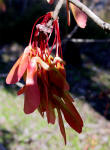
Family - Aceraceae
Red Maple is a medium sized, deciduous tree with an open habit of growth and oval shaped crown found in hardwood swamps, bottom land forests, floodplains of rivers, and along the shores of creeks and lakes, often in conjunction with other hardwoods.
Leaves are medium to dark green above, grayish to silver underneath, with an opposite arrangement, have 3-5 lobes, margins are serrate, the petioles (leaf stems), and central leaf veins are typically pink/red, as are the fruit, young leaves and fall foliage. Small, red flowers are produced in a fascicle in spring, fruit is a red, two winged key (Samara) as is typical of maples. Bark is thin, Grey and smooth in young trees becoming slightly fissured with age. Common names include Scarlet maple and Swamp maple.
The Red maple is noted for its red fall foliage and is used for landscape projects as a fast growing shade tree, for wet locations and for its fall and spring color.
Silver Maple - Acer saccharinum L.
Family - Aceraceae
Native

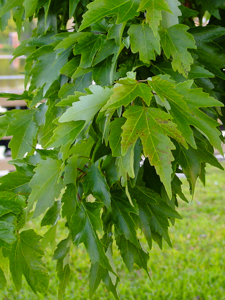

Habitat- The silver maple prefers the moist bottom-lands such as creek and river floodplains, but may also be found on dry upland sites. The silver maple occurs from northeastern Canada south to line approximately even with the southern end of Lake Okeechobee on the east coast of North America.
Growing at a rate of 3-7 feet per year, Silver maple is one of the fastest growing deciduous trees of the eastern and mid-western states. Reaching a height of 70 feet or more. Leaves are 4 - 8 inches long by 2 - 4 inches wide, opposite arrangement, palmate, with 5 lobes, green on top and silvery on the bottom surface with deeply incised, toothed margins.
Carolina Ash - Fraxinus caroliniana
Family - Oleaceae
Native
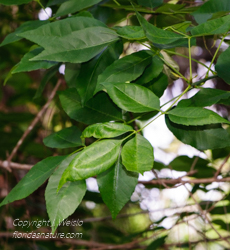
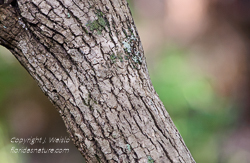
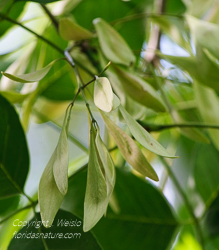
Common names include - Swamp ash, Water ash, Carolina ash, Pop ash
Found growing in swamps and edges of freshwater creeks, ponds, river floodplains. Pop ash is a small tree in South Florida 30-45 feet tall, may have multiple trunks.
Leaves are oppositely arranged, pinnately compound 5 to 10 inches long with 5 to 7 leaflets, leaflets are 2 to 4 inches long usually with serrated margin, dark green above, slightly paler below.
Seed is a broad-winged samara, some with 3 wings 1 1/2 to 2 inches long, 1/2 to 3/4 inch wide, sometimes a reddish-purple color.
Water Hickory, Swamp Hickory - Carya aquatica
Family - Juglandaceae (Walnut Family)
Native
_small.jpg)

_small.jpg)

Habitat - Bottom land forest, floodplains of rivers, seasonally inundated areas
Native tree with a large straight trunk to 100 feet tall and 1 1/2 - 2 1/2 feet in diameter. Leaves are pinnately compound with 9-13 leaflets, leaflets are lance shaped with pointed tips, and are slightly curved.
Pond Apple - Annona glabra
Family - Annonaceae
Invasive / Exotic

_small.jpg)
Habitat - Fresh water Swamps, Wet Forests, Edges of ponds and streams.
Florida native tree. Although it can grow to over 40 feet in height, the Pond Apple is typically smaller. Leaves are leathery, alternate, simple with entire margins, shiny green with pointed apices (tips), leaf margins are generally reflexed upward forming a V from axis.
Flower - Creamy white to pale yellow, 7/8 inch across from triangular buds on short stalks. Pond Apple flowers from spring through summer. Fruit is egg to heart shaped to about 5 inches and is yellow with brown spots.
Florida Fiddlewood - Citharexylum spinosum L.
Family - Verbenaceae
Native


Habitat - Hammocks near the coast in South Florida
Native Florida shrub or small tree, although Fiddlewood can reach a height of nearly 40 feet it is more common in the 15-20 foot range. Bark is smooth, rusty brown - Grey and furrowed on older trees. Leaves are simple, opposite with entire margins, variable in shape from elliptic to obovate even slightly spatulate, thick with edges curled upward. Mid-rib and petioles of leaf pinkish to orange. Small white, fragrant, tubular flowers are borne on racemes (spikes) to a foot in length.
Swamp Cyrilla, Titi - Cyrilla racemiflora
Family - Cyrillaceae
Native


Habitat - Swamps, Wet Pine Flat woods, stream & lake banks
Florida native tree, habit of growth is as a large shrub or small tree to about 30 feet in height. Usually forming thickets, reddish-brown bark and commonly with a twisted, contorted trunks. Leaves are shiny, alternate, variable in size and shape with entire margins. Small, white,five petal flowers borne in long cylindrical clusters in late spring and early summer. Grows best on wet, acidic soils in full sun, but tolerates drier conditions once established.
Melaleuca, a.k.a. Papertree, Punk tree - Melaleuca quinquenervia
Family - Myrtaceae (Myrtle family)
Invasive / Exotic



Habitat- Prefers seasonally flooded areas but also grows in upland habitats.
Height 80 to 100 feet with slender crown, leaves are 4-5 inches long, lance shaped grey-green in color produce a camphor-like smell when crushed. Yellowish-white flowers are produced on bottle brush shaped spikes to 6 inches long, followed by clusters of 3/8 inch round or cylindrical woody capsules
Seeds were intentionally scattered by air over the Everglades in the 1930's with the idea being to help dry out swamps, it is now a major pest in south Florida, particularly in wetland habitats. This fast growing (3-6 feet a year) Australian native forms very dense stands, crowding out all other plants.
Earleaf Acacia - Acacia auriculiformis
Family - Fabaceae
Invasive / Exotic



Compact tree to 50 feet in height, evergreen, commonly with multiple stems/trunks. Leaves are simple, alternate, 5-8 inches long and dark green with flattened stalks. Flowers are yellow-orange in spikes at leaf axis and clusters of spikes at tips of stems. Fruit is a flat oblong pod which twists and splits open as it matures, black seeds hang by a bright orange aril.
Used in landscaping for many years since its introduction as an ornamental. Now found in pinelands, scrubs, hammocks and disturbed areas.